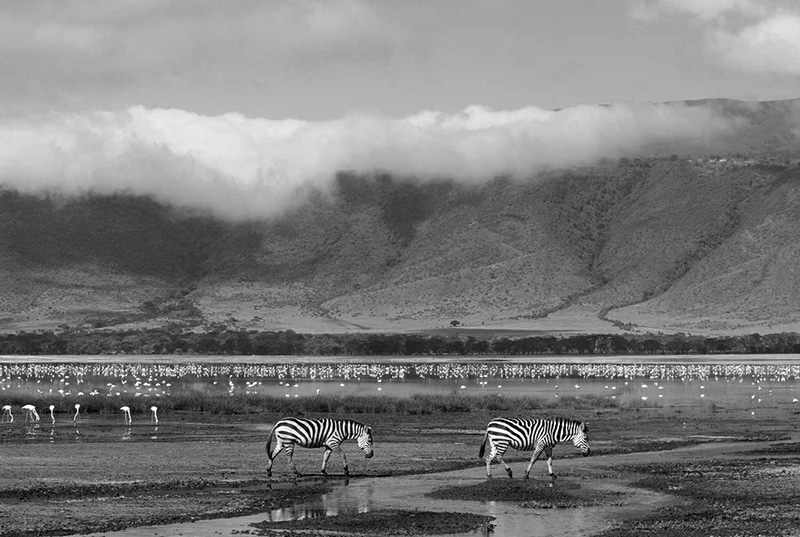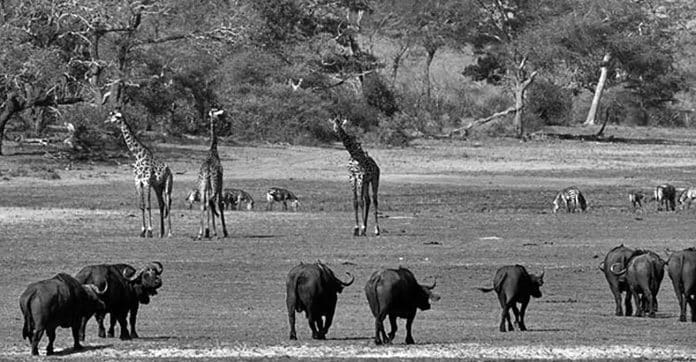List of Protected Areas in Tanzania
An Overview of Tanzania’s Nature Reserves
The protected areas of Tanzania span from the shore to the grasslands to the peak of Africa’s tallest mountain of Kilimanjaro; about a third of the country’s territory is set aside for conservation purposes, such as in-game reserves, national parks, forest reserves, marine parks, and the like.
Below is a list of some of Tanzania’s many protected areas and brief descriptions of their primary ecosystems, animal populations, and plant communities. Species of particular interest (either because they are rare or widespread) have been put in bold.
National Parks
Extending over more than 99,306.5 square kilometers, twenty-two national parks comprise a significant portion of the country’s total protected land area (38,342.5 sq mi). This territory is under the Tanzania National Parks Authority (TANAPA) jurisdiction. Films showcasing African animals have contributed to the popularity of Arusha and the Serengeti.
| S/N | Flora/Fauna | National Park | Comments | Habitat |
| 01. | sable antelope, eland,
roan antelope, crocodile, hippopotamus, lion, elephant, zebra, leopard, waterfowl, buffalo, pelican, topi, |
Katavi National Park gazette: 1974; established:1951 area: 4,471 km² |
above
400 bird species |
floodplain, woodland,
lakes, river, and miombo |
| 02 | Cape buffalo, giraffe, elephant, dik-dik, zebra, hippopotamus, warthog, waterbuck, leopard, eland, klipspringer, spotted hyena, baboon, black-and-white colobus, blue monkey, greater flamingo, lesser flamingo, Maccoa duck, sacred ibis, turaco, Egyptian goose, Narina trogon, giant lobelia, red-hot poker, | Arusha National Park
established: 1960 |
400 bird species | swamp,
dense forest, lakes, grassland, rocks, and alpine highland, 1,525 to 4,565 m |
| 03 | bushbuck, grey duiker, Abbott’s duiker, red forest duiker, eland, leopard, elephant, buffalo, blue monkey, small antelope, black-and-white colobus, Kilimanjaro tree hyrax, galago crassicaudatus, raven, Abbot’s starling, giant lobelia, moss, lichen, papilio sjoestedti, | Kilimanjaro National Park
gazetted: 1973 1921 |
World’s tallest summit to climb without technically orientated tools, highest freestanding mountain. | moorland,
montane forest, alpine desert |
| 04 | Peters’s twinspot, olive baboon, chimpanzee, red-tailed monkey, diademed monkey, red colobus, leopard, buffalo, bushbuck, waterbuck, palm-nut vulture, barbet, African fish eagle, Forbes’ plover, | Gombe Stream National Park
gazetted: 1968 |
Jane Goodall worked here | gallery forest,
miombo woodland, |
| 05 | aloe, protea, red-hot poker, giant lobelia, pelargonium geranium, lilies, asters, Denham’s bustard, blue swallow, cisticola njombe, mountain marsh widow, Kipengere seedeater, eland, chameleon, frogs, lizards, mountain reedbuck, | Kitulo National Park
|
45 varieties of terrestrial orchid, in the 350 species of vascular plants, many bird species | montane grassland
2,600 m |
| 06 | Cape buffalo, elephant, lion, impala, hippopotamus, giraffe, wildebeest, Ayres’s hawk-eagle, zebra, leopard, bushbuck, lesser flamingo, baboon, white pelican, greater flamingo, white-breasted cormorant, yellow-billed stork, palm-nut vulture, cobra, and Nile monitor, | Lake Manyara National Park
established:1957; 1960 area: 325 km²
|
tree-climbing lions, largest biomass density worldwide; | forest,
grassland, lake (2/3), |
| 07 | red-legged sun squirrel, parrots, red colobus, blue monkey, red-tailed monkey, brush-tailed porcupine, giant squirrel, bushy-tailed mongoose, Sharpe’s grysbok, Angolan black-and-white colobus, red-collared widowbird, crowned eagle, speckled mousebird, bee-eater, crested guineafowl, roller, Ross’ turaco, red-winged starling, white-browed robin-chat, violet-backed starling, chimpanzee, | Mahale Mountains National Park
14 June 1985
|
adapted savanna and forest species,
The lake’s 90% of 193 fish species are endemic |
montane rainforest,
miombo forest, (lowland) Kasoge forest, |
| 08 | Waterbirds, greater kudu, vervet monkey, serval, yellow baboon, sable antelope, zebra, lion, hippopotamus, wildebeest, buffalo, impala, giraffe, lilac-breasted roller, elephant, yellow-throated longclaw, eland, bateleur eagle, | Mikumi National Park
extended: 1975 |
Above
400 bird species |
grassland,
floodplain, wooded savanna, miombo covered hills |
| 09 | Mount Meru | Partly – Arusha National Park | ||
| 10 | African wild dog, oryx, black rhinoceros, kudu, and big mammals | Mkomazi National Park
|
Populous for black rhinoceros and African wild dog | Semi-Arid Savanna |
| 11 | Hyena, elephant, African wild dog, cheetah, hippopotamus, giraffe, buffalo, white rhinoceros, crocodile, wildebeest, | Nyerere National Park
gazetted: 2019 |
Tanzania’s largest national park;
previously a northern part of Selous Game Reserve |
open
wooded, miombo woodland, grassland, riverine swamps |
| 12 | yellow-collared lovebird,
hornbill, elephant, kingfisher, white stork, sunbird, African wild dog, greater kudu, sable antelope, crested barbet, |
Ruaha National Park
gazetted:1964 |
Above
400 bird species, and high diversity of antelopes |
Savanna,
Miombo woodland,
|
| 13 | Nile perch, spoonbills, African fish eagle, vervet monkey, hippopotamus, genet, bushbuck, mongoose, sitatunga, malachite kingfisher, grey parrot, paradise flycatcher, storks, herons, yellow-spotted otter, | Rubondo Island National Park
|
lakeside papyrus beds,
humid forest, open grassland,
|
|
| 14 | buffalo, giraffe, warthog, reedbuck, waterbuck, hartebeest, red forest duiker, wildebeest, eland, greater kudu, sable antelope, vervet monkey, yellow baboon, elephant, leopard, lion, spotted hyena, hippopotamus, black-backed jackal, crocodile, lesser, mangrove kingfisher, green turtle, flamingo, | Saadani National Park
Gazetted: 2002 |
It’s a sanctuary bordering the sea | river, coast, savanna, forest, |
| 15 | Saanane Island National Park
Established:2013 |
In the city | ||
| 16 | Black eagle, zebra, wildebeest, lion, elephant, leopard, rhinoceros, cheetah, buffalo, gazelle, spotted hyena, giraffe, jackal, serval, aardwolf, agama lizard, secretary bird, rock hyrax, ostrich, | Serengeti National Park
Gazette:1951 |
Tanzania’s most toured park; populous for massive migration of ungulates;
Over 500 bird species |
savanna, grassland plains,
woodland; riverine forest, |
| 17 | Red-and-yellow barbet, gerenuk, oryx, elephant, lesser kudu, baobab, African wild dog, ground hornbill, lion kori bustard, ostrich, rufous-tailed weaver, yellow-collared lovebird, ashy starling, dwarf mongoose, | Tarangire National Park
Occupied area: 2,850 km² |
Having the most significant concentration of wildlife, only behind Serengeti, and a varieties 550 bird species; | savanna;
grassland,
|
| 18 | Udzungwa partridge, sanje crested mangabey, rungwecerbus kipunji, Iringa red colobus, matundu dwarf galago, amphibians and reptiles, mountain dwarf galago, rufous-winged sunbird, hyrax, squirrel, including big mammals, | Udzungwa Mountains National Park
|
2,500 plant species;
Over 400 bird species, endemics constitute (25% of plant species, 5 primates); 2nd-largest biodiversity in Africa |
2,500 plant species;
Above 400 bird species, 25% of plant species, 5 primates are endemics; second-largest biodiversity in Africa |
Other Tanzania Protected Areas and Game Reserves

| S/N | Flora/Fauna | National Park | Comments | Habitat |
| 01 | zebra, puku, topi, elephant, buffalo, | Uwanda Game
Reserve
|
grassland,
floodplain, woodland 1,200m |
|
| 02 | papilio sjoestedti, zebra, wildebeest, gazelle, lion, black rhinoceros, hartebeest, hippopotamus, spotted hyena, buffalo, mountain reedbuck, elephant, leopard, ostrich, serval, kori bustard, | The Ngorongoro Conservation
world heritage: 1979
area: 8,288 km² |
A lot of paleontological and archeological sites:
Olduvai Gorge, Lake Ndutu, Laetoli, |
lakes, grassland, swamp, heath, woodland,
dense mountain forest
|
| 03 | elephant, African wild dog, cheetah, hippopotamus, giraffe, buffalo, white rhinoceros, crocodile, | Selous Game Reserve was established in1922 A world heritage in 1982 Covering an area of 44,800 km² |
open wooded
miombo woodland, riverine swamps, and grassland,
|
The largest game reserve in Africa;
With about 350 bird species |
Reserves & Marine Parks
| S/N | Flora/Fauna | National Park | Comments | Habitat |
| 01 | Terrapin, whale, coral, dolphin, hippopotamus, crocodile, | Ruvumba’s Mnazi Bay;
An Estuary Marine Park established on 1st July 2000, |
Having above 400 fish species | sand dunes, mangroves, river,
sea, and |
| 02 | mongoose, gold-striped fusilier, queen coris, cigar wrasse, goldbar wrasse, barracuda, grouper, rainbow runner, blue-spotted ribbontail ray, black-spotted ribbontail ray, eagle ray, yellowfin tuna, manta ray, giant trevally, bonito, mackerel, cobia, green turtle, reef shark, hawksbill turtle, duiker, Comoros lesser flying fox, bush pig, elephant shrew, dugong, | Mafia Island Marine Park
Covering an area of 882 km² |
coastal forest,
sea grass beds, coral reefs, inter-tidal flats, mangroves, |
Forestry’s Nature Reserves
NFRs are designated the highest level of protection under the National Forest Act of Tanzania. The Tanzania Forest Services (TFS) Agency is responsible for the upkeep of all state-owned NFRs. Forest nature reserves typically allow for non-commercial scientific study, environmental education, and ecotourism.
- Uzungwa Scarp Nature Forest Reserve
- Chome Nature Forest Reserve
- Amani Nature Forest Reserve
- Kipo Forest Reserve
- Kilombero Nature Forest Reserve
- Magamba Nature Forest Reserve
- Mkingu Nature Forest Reserve
- Mount Hanang Nature Forest Reserve
- Minziro Nature Forest Reserve
- Mount Rungwe Nature Forest Reserve
- Rondo Nature Forest Reserve
- Nilo Nature Forest Reserve
- Uluguru Nature Forest Reserve
Controlled Game Areas
- Handeni Game Controlled Area
- Masailand Game Controlled Area
- Kalimawe Game Controlled Area
- Kitwai Game Controlled Area
- Endulen Game Controlled Area
For more articles related to Tourism in Tanzania, click here!

































